KDEConnect
What is KDE Connect?
KDE Connect is a project that enables all your devices to communicate with each other. Here's a few things KDE Connect can do:
- Receive your phone notifications on your desktop computer and reply to messages
- Control music playing on your desktop from your phone
- Use your phone as a remote control for your desktop
- Run predefined commands on your PC from connected devices. See the list of example commands for more details.
- Check your phone's battery level from the desktop
- Ring your phone to help find it
- Share files and links between devices
- Browse your phone from your desktop
- Control the desktop's volume using your phone
Despite common misconception, you can use KDE Connect on all desktop environments. Since most developers are using Plasma, it may occur that a feature is broken or inaccessible on other desktop environments. In this case, please report it as a bug. There are multiple ways to enhance the KDE Connect experience on non-Plasma desktops. If you are a GNOME user you might prefer GSConnect, a GNOME shell extension. For desktops with AppIndicator support (Budgie, Cinnamon, LXDE, Pantheon, Unity), indicator-kdeconnect is available.
KDE Connect for the moment only supports Android and SailfishOS. The KDE Connect developers are working on supporting more phone os (plasma mobile, postmarketOS, etc. ).
Installation
Before using KDE Connect, you need to install it on your computer through your distro's repositories and your phone.
You can install KDE Connect on your computer by searching it on Discover or using one of the following commands:
- On Debian, Ubuntu and Ubuntu-based distros: sudo apt install kdeconnect
- On Fedora: sudo yum install kdeconnect
- On openSUSE: sudo zypper install kdeconnect
- On Arch and Arch-based distros: sudo pacman -S kdeconnect OR yay -S kdeconnect
A more complete guide explaining how to install KDE software on your computer is available here.
On your phone, KDE Connect is available on the Play Store or on F-Droid.
For SailfishOS, you can find more information in the community store.
Pairing two devices together
First, you need to open KDE Connect on your computer and phone. You should now be able to see in each screen the name of the device you wish to pair with. If it's working, make sure that the two devices are connected to the same network and that there isn't any firewall blocking the two devices from seeing each other. See the troubleshooting section available in the Community wiki.
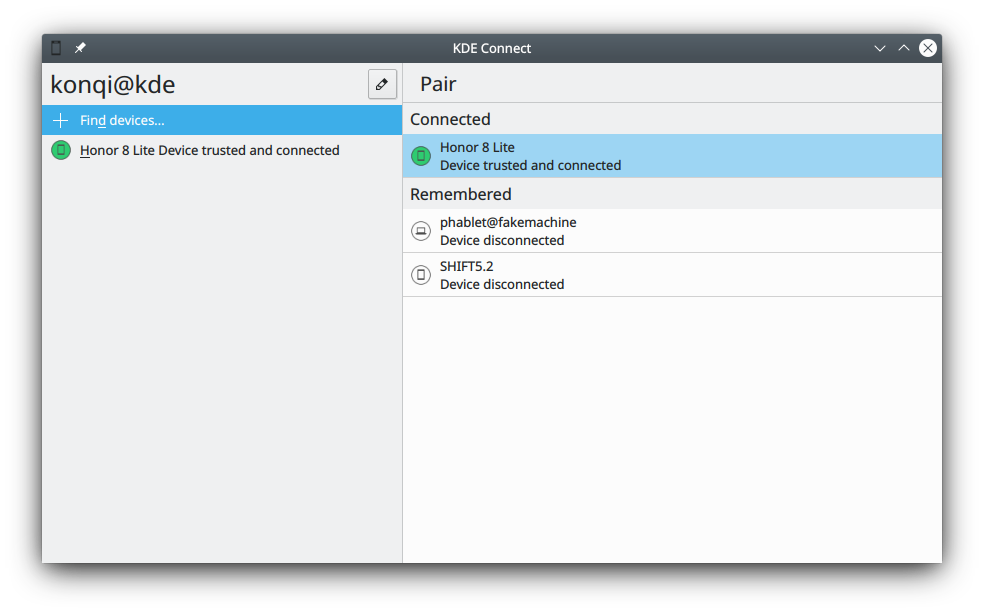
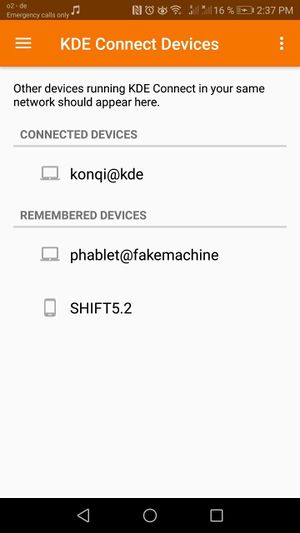
You can now request pairing in one of the two devices. The other device will show a prompt asking to accept the pairing request. Confirm it and that's it! Your devices are now paired.
While a typical configuration might include one computer and one phone, it's also possible to pair two computers instead.
Overview
This is the documentation page for KDEConnect. You can see the community page here [1] which explains what KDEConnect is and how to install it.
KDE Connect has two parts. The desktop program and the phone app.
Changing Device Names
You can only change the name of your device on the device itself. So if you want to change the name of your computer then you must use the desktop program and if you want to change the name of your phone or tablet you must make the change in the KDE Connect app. Once a device is renamed, it will automatically sync with all other connected devices.
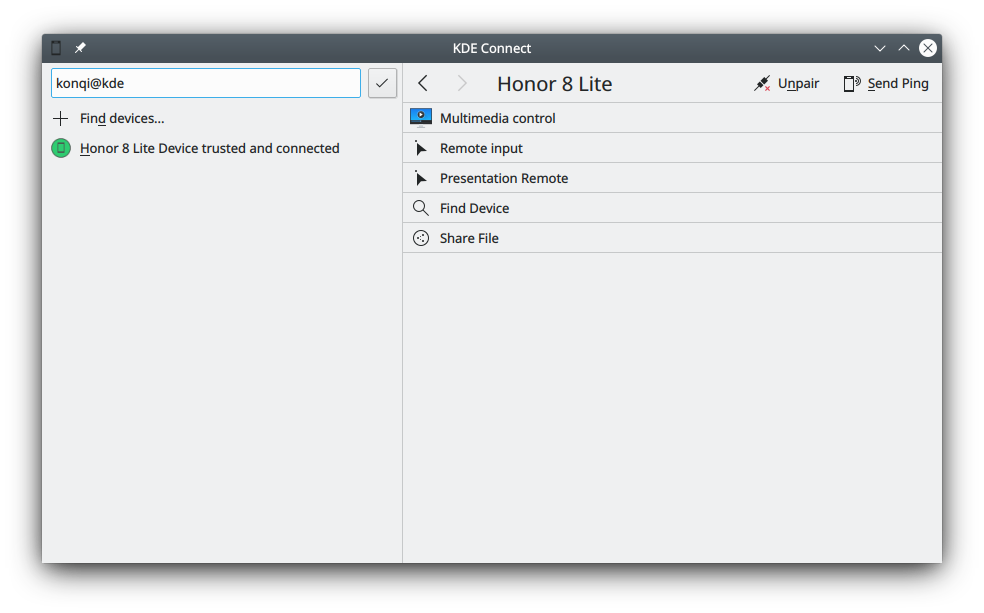
Available Plugins
Battery Monitor
"Show your phone battery next to your computer battery."
By enabling this, the KDE Connect widget on your panel tray will display your phone's battery.

Clipboard
"Share the clipboard between devices."
With this, you can simply copy text from your computer and it will be immediately available to paste on your phone, and vice-versa. This does not work with images though.
Inhibit Screensaver
"Inhibit the screensaver when the device is connected."
This makes sure that your screensaver will not run while your device is connected.
Multimedia Control Receiver
"Remote control your music and videos."
With this feature, you can control your music and videos remotely, with pause/play, previous/next, 5 s before/later. You can also change which media player to control, in addition to application and system volume.

Pause Media During Calls
"Pause music/videos during a phone call."
Pause music/videos during a call. This feature can be powerful when combined with Plasma Browser Integration. For example, when you are listening to some music on Peertube or Youtube, the video will be paused whenever you receive a call.
You can configure this option to pause only when you pick up your phone or directly when your phone starts to ring. You can also decide if you want to only pause the media player or/and mute the system sound.
Ping
"Send and receive pings."
This serves to test your connection to a given device. Once selected, a "Ping!" will appear as a notification on your receiving device.
On your desktop, you can send a ping through the KDE Connect settings or through the widget on the tray.
On your phone, you can send a ping through the upper right hamburger menu on the KDE Connect app.
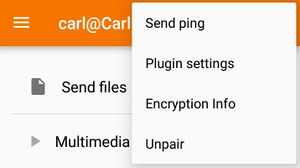
Receive Notifications
"Show your phone notifications on your computer and keep them in sync."
This keeps you in touch with what happens on your phone! Any notifications you receive on your phone will be shown in your computer. Some notifications, such as those of Instant Messengers (IM) like Telegram can be replied on the fly through the computer notification itself.
Remote File System Browser
"Browse the remote device filesystem using SFTP."
This allows you to access your phone storage! When enabled, a device will appear in Dolphin with which you can navigate your external storage.
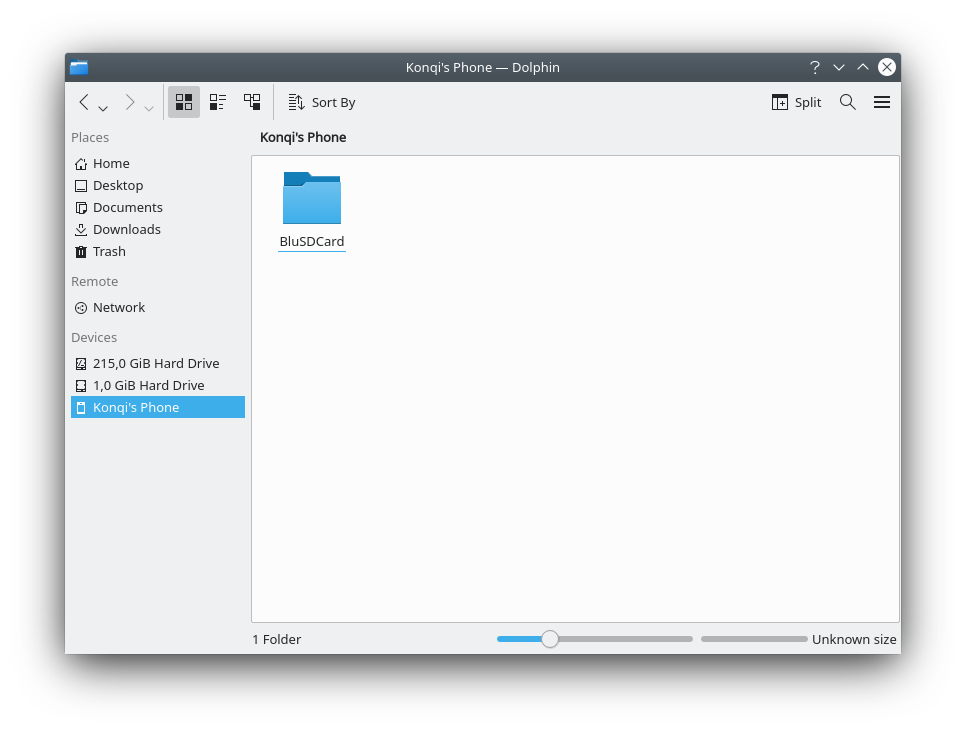
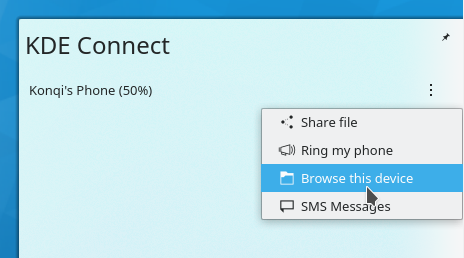
Ring My Phone
"Find your lost phone by making it play an alarm sound."
This also serves to test your connection to a given device, and by ringing your phone remotely, you can quickly find its location!
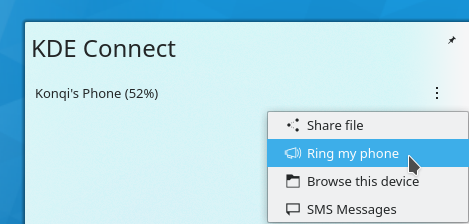
Run Commands
"Execute console commands directly."
With KDE Connect, you can run predefined commands on your computer by pressing buttons on your phone! Instructions on how to add a command are shown in userbase. A set of useful commands can also be found here. Some sample commands, such as suspend and lock screen, are also available.
Send Notifications
"Broadcast this computer's notifications, so they can be shown on other devices."
This is pretty self-explanatory: notifications from your computer will show up in your phone.
You can configure if you want to send the notification description, the icons pertaining to the application and persistent or very important notifications. This keeps you in touch with what happens on your computer! Any notifications you receive on your computer will be shown in your phone.
"Receive and send files, URLs or plain text easily."
This integrates your desktop and your browser so that you can right-click on files or links and send it immediately to your phone!
Files show the right-click option "Send to phone via KDEConnect" and will send the file directly, showing it among your notifications.
Links show the right-click option "Open on phone" and will automatically open your phone's default browser on the chosen website. Really handy!
When receiving files from your phone into your computer, they will go to your Downloads folder by default. If you wish, you can change that too.
Telephone Integration
"Show notifications for incoming calls."
Whenever you get a call on your phone, a notification telling you which number is calling appears. Paired with "Pause media during calls", you'll surely be able to answer readily and never lose a call!
Virtual Input
"Use your phone as a touchpad and keyboard."
With this enabled, by going to your phone app and selecting Remote input, a touch screen will immediately be available for you to control your computer mouse, similarly to a touchpad. One touch equals one click.
The keyboard icon in the upper right allows you to type on your phone and see the result on your computer too.
If you press the hamburger menu right by its side, you'll be able to send right and middle clicks.

